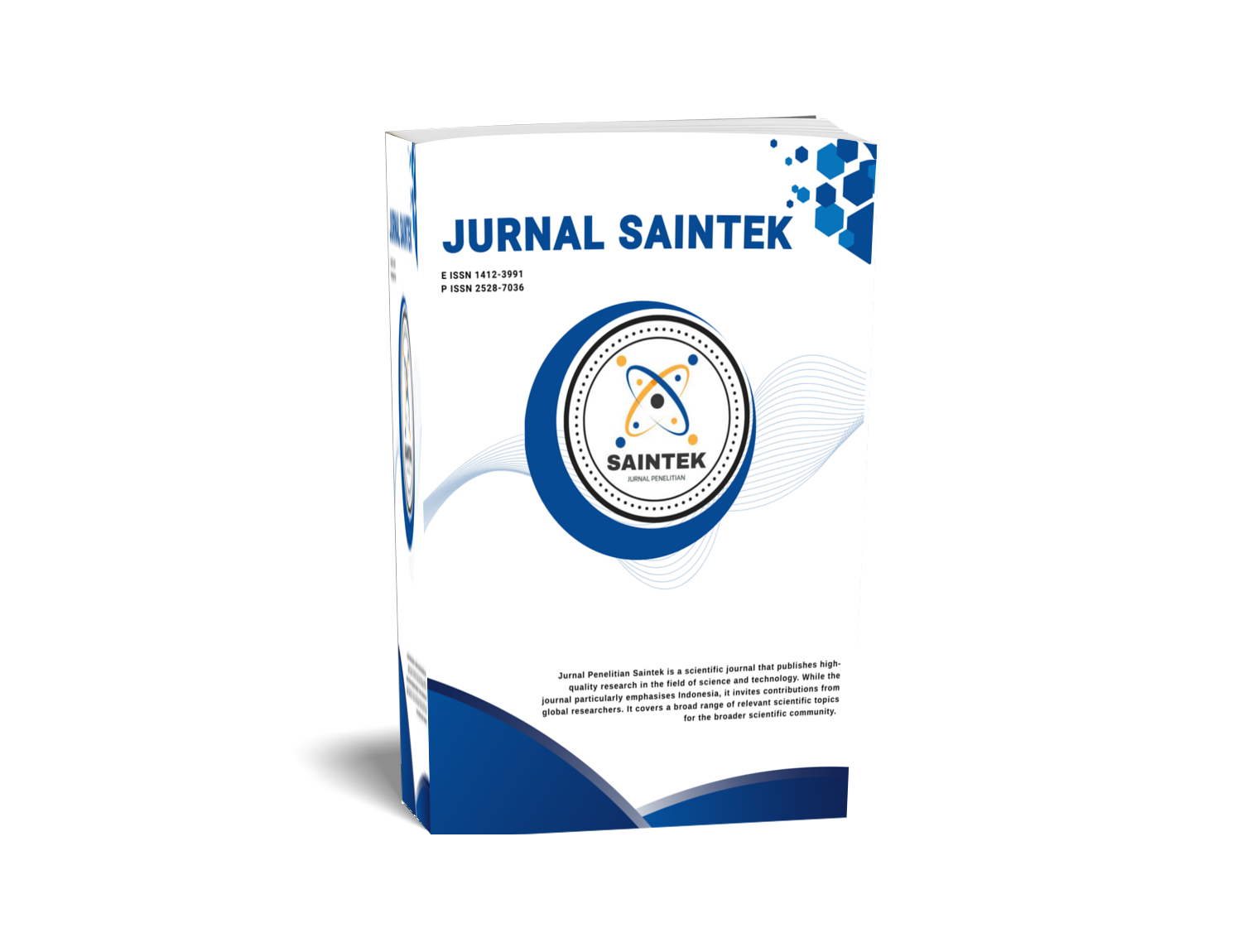PREDIKSI TOTAL PADATAN TERLARUT BUAH MELON GOLDEN MENGGUNAKAN VIS-SWNIRS DAN ANALISIS MULTIVARIAT
DOI:
https://doi.org/10.21831/jps.v25i2.34487Keywords:
melon golden, Vis-SWNIRS, analisis multivariatAbstract
Penelitian ini bertujuan untuk memprediksi total padatan terlarut buah melon golden (Cucumis melo L.) menggunakan Vis-SWNIRS dan analisis multivariat. Terdapat 82 sampel buah melon golden dipilih untuk dianalisis di Laboratorium Hortikultura, Fakultas Pertanian, Universitas Padjadjaran. Nirvana AG410 spectrometer dengan rentang panjang gelombang 300 sampai 1050 nm digunakan untuk pengambilan data spektra pada sampel buah melon utuh. Metode koreksi spektra yang digunakan yaitu Standard Normal Variate (SNV), Multiplicative Scatter Correction (MSC), dan Orthogonal Signal Correction (OSC). Pemodelan kalibrasi dilakukan menggunakan Partial Least Squares Regression (PLSR). Hasil penelitian menunjukkan bahwa penggunaan metode koreksi spektra OSC menampikan model kalibrasi terbaik dibandingkan spektra original dan 2 spektra lainnya yang telah dikoreksi. Koefisien determinasi pada spektra OSC memperlihatkan nilai R2 tertinggi yaitu 0,99. Di samping itu, nilai ratio performance to deviation (RPD) yang diperoleh sebesar 3,40. Hal ini membuktikan total padatan terlarut buah melon golden dapat diprediksi dengan akurasi yang tinggi menggunakan Vis-SWNIRS dan analisis multivariat.
PREDICTION OF TOTAL SOLUBLE SOLIDS OF GOLDEN MELON USING Vis-SWNIRS AND MULTIVARIATE ANALYSIS
This study was aimed at predicting the total dissolved solids of golden melon (Cucumis melo L.) using Vis-SWNIRS and multivariate analysis. There were 82 golden melon fruit samples selected for analysis at the Horticulture Laboratory, Faculty of Agriculture, Padjadjaran University. Nirvana AG410 spectrometer with a wavelength range of 300 to 1050 nm was used to collect spectral data on intact melon fruit samples. The spectra correction methods used were Standard Normal Variate (SNV), Multiplicative Scatter Correction (MSC), and Orthogonal Signal Correction (OSC). Calibration modeling was carried out using Partial Least Squares Regression (PLSR). The results show that the use of the OSC spectra correction method presents the best calibration model compared to the original spectra and 2 other corrected spectra. The coefficient of determination on the OSC spectra shows the highest R2 value, namely 0.99, besides that the ratio performance to deviation (RPD) value obtained is 3.40. This proves that the total dissolved solids of golden melon can be predicted with high accuracy using Vis-SWNIRS and multivariate analysis.
References
Blanco, M., & Villarroya, I. (2002). NIR spectroscopy: A rapid-response analy-tical tool. TrAC - Trends in Analytical Chemistry, 21(4), 240-250. https://doi.org/10.1016/S0165-9936(02)00404-1.
Cen, H., & He, Y. (2007). Theory and application of near infrared reflectance spectroscopy in determination of food quality. Trends in Food Science & Technology, 18(2), 72-83. https://doi.org/10.1016/j.tifs.2006.09.003.
Direktorat Jenderal Hortikultura. (2015). Statistik produksi hortikultura tahun 2014. Diunduh dari http://www.hortikultura.pertanian.go.id
Gardana, C., Scialpi, A., Fachechi, C., & Simonetti, P. (2018). Near-infrared spectroscopy and chemometrics for the routine detection of bilberry extract adulteration and quantitative determination of the anthocyanins. Journal of Spectroscopy, 1–8. https://doi.org/10.1155/2018/4751247
Huang, Y., Lu, R., & Chen, K. (2018). Assessment of tomato soluble solids content and pH by spatially-resolved and conventional Vis/NIR spectroscopy. Journal of Food Engineering, 236(3), 19–28. https://doi.org/https://doi.org/ 10.1016/j.jfoodeng.2018.05.008.
Jamshidi, B., Minaei, S., Mohajerani, E., & Ghassemian, H. (2012). Reflectance vis/NIR spectroscopy for nondestructive taste characterization of Valencia oranges. Computers and Electronics in Agriculture, 85, 64–69. https://doi.org/10.1016/j.compag.2012.03.008
Jankovská, R., & Å ustová, K. (2003). Analysis of cow milk by near-infrared spectroscopy. Czech Journal of Food Sciences, 21(4), 123–128. https://doi.org/10.17221/3488-cjfs
Kusumiyati, Hadiwijaya, Y., & Putri, I. E. (2019). Non-destructive classification of fruits based on vis-NIR spectroscopy and principal component analysis. Jurnal Biodjati, 4(1), 89–95. https://doi.org/10.15575/biodjati.v4i1.4389
Kusumiyati, Hadiwijaya, Y., Putri, I. E., & Mubarok, S. (2019). Water content prediction of crystal guava using visible-near infrared spectroscopy and chemometrics approach. IOP Conference Series: Earth and Environmental Science. https://doi.org/10.1088/1755-1315/393/1/012099.
Kusumiyati, Hadiwijaya, Y., Putri, I. E., Mubarok, S., & Hamdani, J. S. (2020, February). Rapid and non-destructive prediction of total soluble solids of guava fruits at various storage periods using handheld near-infrared instrument. IOP Conference Series: Earth and Environmental Science, 458(1), p. 012022. https://doi.org/10.1088/1755-1315/458/1/012022.
Kusumiyati, Mubarok, S., Hamdani, J. S., Farida., Sutari, W., Hadiwijaya, Y., Putri, I. E., & Mutiarawati, T. (2018). Evaluation of sapodilla fruit quality using near-infrared spectroscopy. Journal of Food, Agriculture and Environment, 16(1), 49-53.
Maniwara, P., Nakano, K., Boonyakiat, D., Ohashi, S., Hiroi, M., & Tohyama, T. (2014). The use of visible and near infrared spectroscopy for evaluating passion fruit postharvest quality. Journal of Food Engineering, 143, 33-43. https://doi.org/10.1016/j.jfoodeng. 2014.06.028.
Nicolaí¯, B. M., Beullens, K., Bobelyn, E., Peirs, A., Saeys, W., Theron, K. I., & Lammertyn, J. (2007). Nondestructive measurement of fruit and vegetable quality by means of NIR spectroscopy: A review. Postharvest Biology and Technology, 46(2), 99-118. https://doi.org/10.1016/j.postharvbio.2007.06.024
Pissard, A., Baeten, V., Romnée, J. M., Dupont, P., Mouteau, A., & Lateur, M. (2012). Classical and NIR measure-ments of the quality and nutritional parameters of apples: A methodological study of intra-fruit variability. Biotechnology, Agronomy and Society and Environment, 16(3), 294-306.
Rinnan, í…., Van Den Berg, F., & Engelsen, S. B. (2009). Review of the most common pre-processing techniques for near-infrared spectra. Trends in Analytical Chemistry, 28(10), 1201-1222. https://doi.org/10.1016/J.TRAC.2009.07.007.
Saad, A. G., Jaiswal, P., & Jha, S. N. (2014). Non-destructive quality evaluation of intact tomato using VIS-NIR spectroscopy. International Journal of Advanced Research, 2(12), 632–639.
Sánchez, M. T., De La Haba, M. J., Benítez-López, M., Fernández-Novales, J., Garrido-Varo, A., & Pérez-Marín, D. (2012). Non-destructive characterization and quality control of intact strawberries based on NIR spectral data. Journal of Food Engineering, 110(1), 102-108. https://doi.org/ 10.1016/j.jfoodeng.2011.12.003.
Sharabian, V. R., Noguchi, N., & Ishi, K. (2014). Significant wavelengths for prediction of winter wheat growth status and grain yield using multivariate analysis. Engineering in Agriculture, Environment and Food, 7(1), 14–21. https://doi.org/10.1016/j.eaef.2013.12.003
Soltanikazemi, M., Mehdizadeh, S. A., & Heydari, M. (2017). Non-destructive evaluation of the internal fruit quality of black mulberry (Morus nigra L.) using visible-infrared spectroscopy and genetic algorithm. International Journal of Food Properties, 20(11), 2437–2447. https://doi.org/10.1080/10942912.2016.1238930
Torres, I., Pérez-Marín, D., De la Haba, M. J., & Sánchez, M. T. (2015). Fast and accurate quality assessment of Raf tomatoes using NIRS technology. Postharvest Biology and Technology, 107, 9-15. https://doi.org/10.1016/j.postharvbio.2015.04.004
Vitale, R., Bevilacqua, M., Bucci, R., Magrí¬, A. D., Magrí¬, A. L., & Marini, F. (2013). A rapid and non-invasive method for authenticating the origin of pistachio samples by NIR spectroscopy and chemometrics. Chemometrics and Intelligent Laboratory Systems, 121, 90-99. https://doi.org/10.1016/j.chemolab.2012.11.019
Zude, M. (2003). Non-destructive prediction of banana fruit quality using VIS/NIR spectroscopy. Fruits, 58(3), 135-142. https://doi.org/10.1051/fruits:2003001.
Downloads
Published
How to Cite
Issue
Section
Citation Check
License
Who Can Submit?
Any individual may submit an original manuscript for consideration for publication in Jurnal Penelitian Saintek as long as they hold the copyright to the work or are authorized by the copyright owner(s) to submit it. Authors retain initial ownership of the copyrights to their works prior to publication, except in cases where, as a condition of employment, they have agreed to transfer copyright to their employer.
User Rights
Jurnal Penelitian Saintek is an Open Access journal. Users are granted the right to read, download, copy, distribute, print, search, or link to the full texts of articles, provided they comply with the conditions of the Creative Commons Attribution-ShareAlike License 4.0 (CC BY-SA 4.0).
https://creativecommons.org/licenses/by-sa/4.0/
Author Rights
Authors retains copyrights.
Jurnal Penelitian Saintek by http://journal.uny.ac.id/index.php/saintek is licensed under a Creative Commons Attribution-ShareAlike 4.0 International License.









